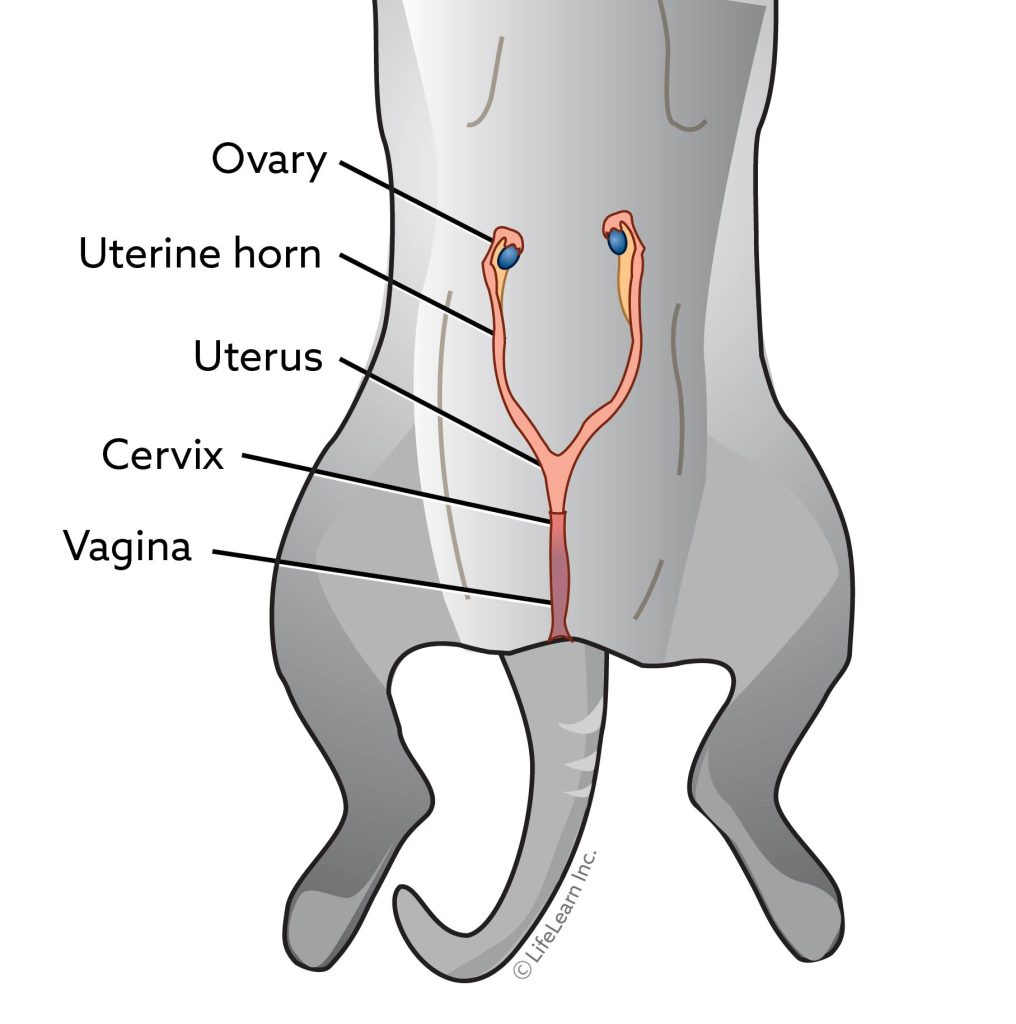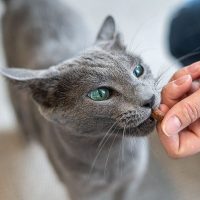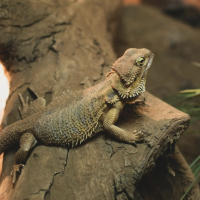What is meant by ovariohysterectomy or spaying?
Spaying is the common term used to describe the surgical procedure known as an ovariohysterectomy. In this procedure, the ovaries and uterus are removed completely in order to sterilize a female cat.

Why should I have my cat spayed?
It is recommended that all non-breeding cats be sterilized. Several health benefits are associated with spaying your cat. First, spaying eliminates the risk of ovarian and uterine cancers. Second, breast cancer is the number one type of cancer diagnosed in intact (unspayed) female cats. If your cat is spayed before her first heat cycle, there is less than ½ of 1% (0.5%) chance of developing breast cancer. With every subsequent heat cycle, the risk of developing breast cancer increases. After about 2½ years of age, ovariohysterectomy offers no protective benefit against developing breast cancer.
Unspayed female cats also carry the risk of developing pyometra – a fatal condition of the uterus that requires surgery to treat.
Finally, cats with diabetes or epilepsy should be spayed to prevent hormonal changes that may interfere with medications.
Are there other benefits to spaying my cat?
The most obvious benefit is the prevention of unplanned pregnancies. There is no behavioral, medical, or scientific reason for letting your cat have a litter before she is spayed.
“There is no behavioral, medical, or scientific reason for letting your cat have a litter before she is spayed.”
Once a cat reaches puberty, usually at around seven months of age, she will have a heat or estrous cycle every two to three weeks for most of the year, unless she becomes pregnant. She will be ‘in heat’ or receptive to mating for approximately one week in each cycle. During heat, she may display unsociable behavior such as loud and persistent crying and frequent rubbing and rolling on the floor. She may also urinate outside her litterbox as a marking behavior. This behavior coupled with her scent, will attract male cats from miles around. Removal of the ovaries will stop her estrous cycles.
When should I have my cat spayed?
There are many different factors to weigh when determining the optimal time to spay a kitten, including health factors, behavioral factors, and your pet’s environment. Talk to your veterinarian to determine the best time to spay your pet.
What does a spay surgery involve?
This major surgical procedure requires general anesthesia. You will need to fast your cat the night prior to surgery. Most cats return home the day of the surgery. Your veterinarian will advise you on aftercare procedures, and any other details specific to your cat.
“You will need to fast your cat the night prior to surgery.”
The operation is performed through a relatively small incision made most commonly in the midline of the abdomen, just below the umbilicus. Both ovaries are removed along with the entire uterus. The surgical incision will be closed with several layers of sutures. In many cases, skin sutures will be placed, and these will be removed after 14 days.
Are complications common with spaying?
In general, complications are rare during an ovariohysterectomy surgery. However, as with any anesthetic or surgical procedure, there is always a small risk. The potential complications include:
Anesthetic reaction. Any individual cat can have an unexpected adverse reaction following the administration of any drug or anesthetic. Such cases are impossible to predict, but are extremely rare.
Another potential danger associated with anesthesia arises if the cat is not properly fasted prior to anesthesia. Anesthetized patients lose the normal reflex ability to swallow; during swallowing, the epiglottis, a cartilage flap at the entrance to the windpipe, closes and prevents food or water from entering the lungs. If there is food in the stomach, the cat could vomit while under anesthesia or in the early post-anesthetic period, allowing the food to enter the lungs and cause aspiration pneumonia, a potentially life-threatening condition.
Illness will increase the risks associated with anesthesia. Pre-surgical blood work is a useful screening test that may detect pre-existing problems that could interfere with the pet’s ability to handle anesthetic drugs.
To minimize the risks, it is important that all pre-surgical instructions are strictly followed and that you report any signs of illness or previous medical conditions to your veterinarian prior to any sedation, anesthesia, or surgery.
Internal bleeding. This can occur if a ligature around a blood vessel breaks or slips off after the abdomen has been closed. This is very rare, and is more likely to occur if the cat is extremely active. Clinical signs include weakness, pale gums, depression, anorexia, or a distended abdomen.
Post-operative infection. This may occur internally or externally around the incision site. In most cases, the infection can be controlled with antibiotics. A post-operative infection most commonly occurs when the cat licks the site excessively or is in a damp environment.
Suture reaction or sinus formation. Although extremely rare, occasionally the body will react to certain types of suture material used during surgery. This results in a draining wound or tract that may appear up to several weeks after the surgery was performed. Often a further operation is required to remove the suture material.
Seroma. A seroma is a non-painful pocket of relatively clear fluid involving the incision. It contains serum (the water portion of blood) that has leaked under the skin. This usually occurs if the cat has been too active in the first few days after surgery. Seromas will resolve over time but some can open onto the skin, often needing antibiotics to prevent secondary infections.
Will spaying have any adverse effects on my cat?
In the vast majority of cats, there are no adverse effects following an ovariohysterectomy. In certain cats, notably the Siamese breed, the hair that grows back over an operation site may be noticeably darker, believed to be due to a difference in the skin temperature. This darker patch usually grows out with the following molt as the hair is naturally replaced.
“There are many myths and beliefs about spaying that are not supported by facts or research.”
There are many myths and beliefs about spaying that are not supported by facts or research. Be sure to discuss any questions or concerns you may have with your veterinarian prior to surgery.
Does spaying cause my cat to get fat?
Spaying does decrease the metabolism of your cat and may lead to a more sedentary lifestyle. This will cause your cat to put on weight; however, if you monitor their body condition and make appropriate adjustments to their nutrition and lifestyle – including regular exercise time – you can prevent this weight gain.
© Copyright 2021 LifeLearn Inc. Used and/or modified with permission under license.






